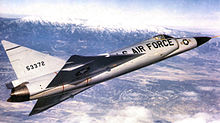
This is a list of United States Air Force F-106 Delta Dart Squadrons. The F-106 is considered one of the finest all-weather interceptors ever built. It served on active duty with the United States Air Force Air Defense Command (and successor organizations) and Air Defense squadrons of the Air National Guard for almost 30 years, much longer than most of its contemporaries.
Originally designated the F-102B, it was redesignated F-106 because of extensive structural changes and a more powerful engine. The first F-106A flew on 26 December 1956, and deliveries to the USAF began in July 1959 with the 539th Fighter-Interceptor Squadron at McGuire AFB, New Jersey. Production ended in late 1961 after 277 single-seat F-106As and 63 two-seat F-106B trainers had been built. The last squadron to relinquish its F-106s was the 119th Fighter-Interceptor Squadron of the New Jersey Air National Guard, which sent its last plane to AMARC in August 1988.
The last operator of the F-106 was the 82d Aerial Targets Squadron, which used retired F-106s as target drones beginning in 1990. The last shoot down of a QF-106 (57-2524) took place at Holloman AFB on 20 February 1997. The last unexpended flyable 82d ATS QF-106 drone was sent to AMARC in January 1998 for storage.
Air Defense Command/ADTAC Squadron Assignments
Number of aircraft assigned in parentheses
|
|
Air National Guard Squadron Assignments
Number of aircraft assigned in parentheses
|
|
Other USAF Assignments
|
|
In addition to the USAF, F-106s were operated in limited numbers by Convair, Rockwell International and Hughes Aircraft for Air Force testing programs, and by NASA for almost 40 years (1961–1999).
References
- USAF Aerospace Defense Command publication, The Interceptor, January 1979 (Volume 21, Number 1).
- Maurer, Maurer, ed. (1982) . Combat Squadrons of the Air Force, World War II (PDF) (reprint ed.). Washington, DC: Office of Air Force History. ISBN 0-405-12194-6.
- Rogers, Brian. (2005). United States Air Force Unit Designations Since 1978. Hinkley, UK: Midland Publications. ISBN 1-85780-197-0.
![]() This article incorporates public domain material from the Air Force Historical Research Agency
This article incorporates public domain material from the Air Force Historical Research Agency